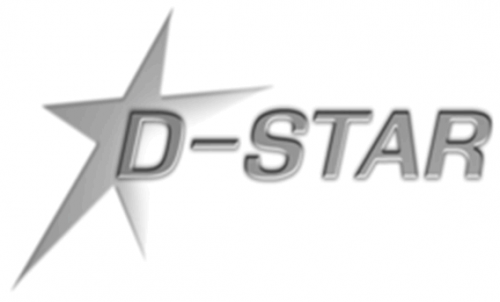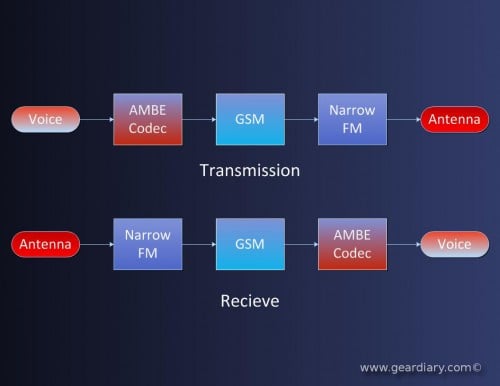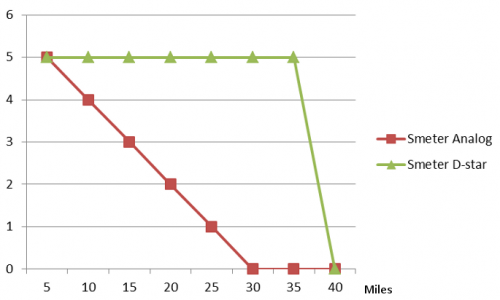D-Star is the newest mode I have recently added to my Amateur Radio arsenal. I bought an Icom ID-31A D-star, radio which I will be reviewing here soon, but I wanted to share a little about D-star and why it’s a cool mode before I did the review.
The History of D-Star
D-star is a mode that was created by the Japanese Amateur Radio League in 2001 after doing three years of research. JARL designed it as an open standard so that manufacturers could build the radios. Icom is the first company to make radios for D-star, however they aren’t the only ones who do; in Japan, D-star radios are also made by Kenwood. However here in the states, Icom is the only manufacturer that produces D-star radios.
D-star is an open standard only in that anyone can choose to make radios that use the standard. However, D-star is currently dependent on the AMBE (Advanced Multi-Band Excitation) codec, which is built into a chip that is included on every D-star radio. This codec currently is patented and requires a license to be purchased by the manufacturer from Digital Voice Systems, Inc. It’s only recently that the prices of the license and this chip have come down to make it cost-effective to be included in many radios. The first radio, the Icom ID-1 which is on the 1.2 GHz Amateur Radio band, is still available today and is still very pricey at $999.95. The original MSRP on this radio was $1600 dollars, so as you can see, D-star started off as a really expensive mode and really took a while to gain in popularity. Within the last few years, with both 2 m and 70 cm bands getting radios, D-star has exploded. There was a long time where we didn’t have any repeaters here in Columbus, but we now have 2 different repeaters with modules on 2m, 70cm and one machine has modules on 23 cm(1.2 GHz) as well. Worldwide, about 6 repeaters are going on-line per month making it even more viable every month.
So what is it?
D-star stands for Digital Smart Technology for Amateur Radio. What it essentially is being used for today is for voice communication over a digital medium similar to your cell phone or a Skype session. In fact, it even uses similar technologies to a modern GSM smart phone.
The above graphic is a very simplified flow of communications from one radio to another using D-star. It’s similar to FM radio, and it even uses FM in its flow. However, it does much more. Your voice plus data is sent to the AMBE chip. From the AMBE chip it goes to a GSM chip to prepare it to be sent to the analog FM radio. From the GSM chip it goes to FM(Frequency Modulation) radio and on to the antenna. On the other end, it’s the reverse. The antenna picks the signal up as a FM signal, sends it to the GSM chip and then to the AMBE chip where the data and voice are split apart and then you hear the station as well as see any data he’s sent along with the transmission. This all sounds complicated and it is, but in the end, it’s very simple for you to use once it’s all packaged in a radio.
Since D-star is a digital mode even when your voice is involved, it has many unique properties that really make a difference when it comes to range. If you have ever listened to AM or FM radio you are familiar with how these signals will degrade as you move away from the station. The same thing happened when we used analog television as well. The farther you got away, the more static a station got until the static was louder than the radio stations signal. Amateur Radio modes like FM, AM and SSB also have the same kind of degradation. Well, with D-star, you need less signal as you are transmitting bits or ones and zeros. D-star and other digital modes do not have fading like analog, because there’s either enough bits for the radio to decode into a signal or there isn’t. That means you always hear the other station at full strength until ‘he drives off the cliff’, as we call it. One minute the station will be there and the next he’s not. It’s because of this property of digital signals that you get, on average, a 30 percent increase in range with the same transmitter over the analog modes.
D-star has two primary modes. The first, and most common mode is DV, or Digital Voice. In this mode, you talk as you normally would on an analog repeater, but it’s now digital on the D-star repeater. Before I go into how that works, a repeater in layman’s terms is just as it sounds. It repeats what it hears. So you key up, and it simultaneously transmits what you say at a high power level. In both the analog world of FM and D-star it increases the range of the local stations; in the D-star world it can get more interesting.
What do I mean? Well instead of tuning in to the repeater as you normally would, you can also do some pretty fancy stuff that really makes D-star fun. The first is using the gateway that is built into most D-star repeaters. The gateway is, essentially, a connection to the internet. The repeaters connection to the internet allows you to easily link to other repeaters on the fly. You can also link to what I like to call internet repeaters, but it is truly called a reflector. Reflectors are set up so that you can connect your local repeater to the reflector, and other hams can also do the same with their local repeater. Reflectors are usually setup for specific reasons. The most commonly used reflector out there is reflector 01C. Some people call this one the megarepeater as there’s almost always someone connected to the reflector. Using this reflector, I’ve been able to chat with stations in England, Columbia, Scotland, Japan, Germany, Russia as well as the United States. Today while walking my dog, I chatted with NG9P, whose name is Dale, and at the time was located in Illinois. When I first got my license, the only way you could talk to the world was to use a High Frequency or HF radio. Those are usually not very portable due to the higher power needed, as well as antenna systems that measure not in inches but FEET. It’s not very convenient to carry the 16 foot antenna needed to work on the 10 m band while your walking your dog. With D-star you can do this easily from almost any location.
The second, and less common mode on D-star is DD or digital data. The DD mode is usually reserved for the 23 cm (1.2GHz) band. For that, you’d use the Icom ID-1 radio. This radio connects to your computer with an ethernet cable turning the ID-1 into a wireless amateur radio network, essentially. You can see other people’s hard drives and transfer files over the ID-1 as long as you are keeping the FCC regulations in mind (IE: No smut and no commercial use). The speeds we are talking here aren’t anywhere close to 4G or even 3G, but they are pretty decent at 128K. This is much higher speed than commonly used amateur radio packet modes on 2 m and 70 cm which top out at 9600 baud. This could be very useful for transferring pictures from one local disaster site to another. DD mode can also be used with repeaters with gateways as well. Technically you could also use this to get internet access, but because of the possibilities of coming across questionable content, I would use traditional Internet services rather than relying on the ID-1.
Conclusion
D-star is the very thing that Amateur Radio needs. Right now there just isn’t as much interest in the hobby like there was when I was a kid. It’s seeing a resurgence thanks to the elimination of the morse code requirement, but it’s still not near the levels it was in my grandfather’s day. In that time, Ham Radio was at the forefront of technology; they did things no one else did, APRS did position reporting and tracking before Google did with Google Latitude. There were whole companies that started out of someone’s desire to make something that wasn’t, and instead of patenting it they sold the parts and plans so you could make it too. When the internet came along, it basically made what we did on ham radio common place. I am part of a podcast that has people in 4 different states and an occasional guest from outside of the country and it happens on a weekly basis. That makes ham radio look less interesting, because it’s so easy to do that with today’s technology — plus you don’t need a license to use Skype, Google Hangouts or Mumble. D-star helps a lot with this. You still need a license, but just this morning I was able to have a short round table conversation with M6DER from the UK and ZL1LIU from New Zealand all while taking my dog for a walk. How cool is that?
While D-star is just the first new mode I added in the last few years, I hope that I will be adding something even more interesting in the coming months. Stay tuned, and I’ll share what I learn as I continue my journey in Amateur Radio. If you decide you want to make the jump into Amateur Radio and want to know what to do first, feel free to drop me a line! 73 (Best Regards in Ham Lingo)



